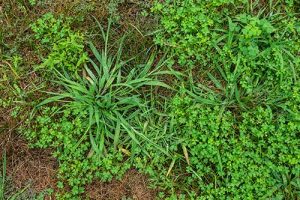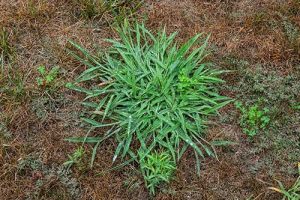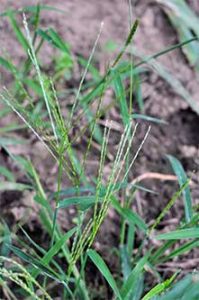How To Get Rid of Crabgrass: The Comprehensive Guide
 When you are trying to grow a lush, green lawn, it is aggravating to see weeds randomly popping up in the middle of your beautiful turf. It is even more frustrating when that nuisance weed is crabgrass.
When you are trying to grow a lush, green lawn, it is aggravating to see weeds randomly popping up in the middle of your beautiful turf. It is even more frustrating when that nuisance weed is crabgrass.
Seeing crabgrass shouldn’t make you throw your hands up in despair — with some time and effort, you can get rid of it from your yard.
Crabgrass is commonly found in lawns during the summer months. The flat, wide blades are easy to see in your turf, and when left uncontrolled, crabgrass can spread rapidly. Keeping your grass healthy and strong is the best preventative, especially when coupled with early-season applications of pre-emergent herbicides. Once seeds germinate, they are much harder to control but can be sprayed with herbicide or manually pulled.
What Is Crabgrass And What Does It Look Like?
Crabgrass is the common name for two grass plants in the genus Digitaria — smooth and hairy crabgrass. These two plants are the most troublesome weeds found in lawns and turf and are found almost everywhere across the United States.
- Smooth or small crabgrass (Digitaria ischaemum) grows low to the ground and has almost no hairs on the blades of grass, except at the plant’s auricles.
- Hairy or large crabgrass (Digitaria sanguinalis) is more common in lawns. The leaf blades grow longer and are covered in small hairs.
Surprisingly, crabgrass poses very little threat to your lawn and doesn’t crowd out your warm-season Bermuda or Zoysia grass. The biggest concern with crabgrass is that it dies off late in the summer, leaving patches of dead, brown grass throughout your backyard.

Crabgrass is relatively easy to spot in your lawn. Instead of growing upright, it has a more spreading habit than turf, growing low to the ground. The blades are wide and flat and lighter green than most types of turf. When mature, it produces long flower clusters containing thousands of seeds.
How Does Crabgrass Spread?
Unlike many other types of grasses, crabgrass doesn’t spread by underground rhizomes. Instead, it spreads solely via seed. The problem is that each plant produces long flower clusters with up to 150,000 seeds in its short life cycle. On top of that, seeds can remain viable on the soil surface for years before germinating.
Due to its low-growing, spreading nature, flowers and seeds may develop when the plant is only ½” tall. This height is much shorter than the recommended mowing height for lawn, so mowing the tops off may not prevent crabgrass from flowering and going to seed.
What Helps To Prevent Crabgrass?

For a healthy lawn:
- Overseed any thin or bare spots to fill patches in with grass.
- Mow grass no lower than 3” in height. This taller height keeps the soil surface shaded from the sunlight and cooler in temperature, helping to see crabgrass seeds from germinating.
- Water the lawn infrequently but deeply versus daily, light irrigation. Watering less frequently promotes deeper root growth, making the grass more drought-tolerant and hardy.
Along with fostering a healthy yard, you can apply a pre-emergent herbicide in the early spring to prevent crabgrass seedlings from establishing. Unfortunately, they don’t always stop the seeds from germinating completely — which is a misconception many homeowners have about this type of weed killer — but instead, they inhibit shoot or root development so that seedlings can’t become established plants.
When To Put Down Crabgrass Preventer On Lawn
If you choose to apply a preventative weed killer to your lawn, it is critical to time the application correctly. The most effective time to apply pre-emergent is in the early spring when soil temperatures are still cool.
1 UMass Extension Turf Program, “Biology and Management of Crabgrass,” University of Massachusetts Amherst, May 2011.
Soil temperatures need to consistently be above 55℉ for a few days for crabgrass seeds to germinate. Therefore, the best time to apply pre-emergent is when soil temperatures are between 50 and 55℉, just before germination occurs. A general rule of thumb is to time application to late March or early April when the dogwoods and forsythia plants begin blooming.
Some essential tips for applying a pre-emergent:
- Apply a pre-emergent product just before it rains, so the rain washes the herbicide into the soil. Or water it using a sprinkler.
- Also, keep timing in mind if you plan to overseed areas of the lawn since a pre-emergent will stop turf seeds from establishing. Some products are effective for up to 12 weeks after application.
How To Kill Crabgrass In The Summer
Once crabgrass seeds have germinated and taken root, the plants aren’t as easy to control because they go to seed so quickly. This is frustrating if you are trying to eliminate crabgrass from your yard, but don’t get discouraged. It is possible to kill crabgrass in the summer.
How you approach the crabgrass problem depends on where the weeds are growing.
To kill crabgrass in the lawn, apply a selective post-emergent herbicide formulated to kill crabgrass and other grassy weeds. Selective herbicides only affect the target plants listed on the product label, so they won’t kill the lawn grasses you are trying to maintain.
Suppose you’re battling crabgrass in the garden or your flowerbeds versus the lawn. In this case, you can choose to use a broad-spectrum herbicide. Unlike a selective herbicide, a broad-spectrum weed killer (i.e., glyphosate) kills everything it contacts. Be careful you don’t accidentally spray it on plants you want to keep alive.
When applying a post-emergent herbicide:
- Always follow the safety instructions on the label.
- Apply product at the recommended rate.
- Spray when there is little wind to prevent drift, regardless of the type of herbicide you are using.
- Try to spray weeds when the plants have developed their first true leaves but haven’t yet reached the 3-leaf stage. Herbicides are most effective at this stage in life.
A word of caution, though. St. Augustine grass is sensitive to chemicals found in certain selective, post-emergent herbicides. Make sure the product you choose clearly states it’s safe for use on St. Augustine grass, or you can damage your lawn.
2 Nebraska Extension, “Soil Temperatures and Spring Preemergence Herbicide Applications,” University of Nebraska.
Some Options to Eliminate Crabgrass Naturally
For homeowners wanting a more natural approach to eliminate crabgrass, there are a couple of non-chemical options. These methods are more environmentally sustainable but may take longer to get rid of the weeds. You can pull weeds by hand or apply corn gluten meal as a pre-emergent.
The first option is to pull crabgrass plants by hand. To make pulling weeds easier and more successful:
- Pull crabgrass plants as soon as you see them. Smaller plants are easier to pull than larger ones.
- Try to remove all of the roots if possible when pulling crabgrass. Grab each plant by the base and pull slowly and steadily upwards.
- Weed just after it rains or water the lawn thoroughly.
- Use a weeding tool such as a hoe or a weed popper.
Manual removal is the most labor-intensive option and may not be feasible for homeowners with physical limitations.
Corn gluten meal can also be used as an alternative to chemical pre-emergents, applied at a standard rate of 20 pounds per 1,000 square feet of lawn. It is an organic approach that prevents roots from establishing after the seeds germinate.
Using corn gluten meal for crabgrass control isn’t as straightforward as chemical options. Timing is critical and impacts the effectiveness considerably. Corn gluten meal may also take more than one application to see the full benefits, and it may not get rid of the crabgrass entirely.
Corn gluten meal must be applied before seeds germinate and take root.
After application, it needs to be watered into the soil within five days.
There needs to be a two or three-day dry period following germination for the corn gluten meal to work. If conditions are still wet, the seedling can recover and form roots.
Our Conclusion on Preventing Crabgrass In Your Lawn
As a homeowner, it can be discouraging to see crabgrass pop up in your lush, green lawn. Eradicating crabgrass is challenging and will likely take more than one season to get rid of it completely. It is possible, though, to get rid of bringing your yard back to its pristine state.
The best method of success is an approach utilizing both chemical and cultural practices — keeping your lawn healthy and strong while trying to minimize the germination of crabgrass seeds in the early spring.
Don’t Have Time To Deal With Crabgrass Lawn Treatment?
We can take care of this for you! Our Ryan Lawn & Tree professionals will take care of removing crabgrass from your lawn.
Get a Free Estimate for crabgrass treatment in any one of our locations including Kansas City, St. Louis, Tulsa, Wichita, or Springfield today!









